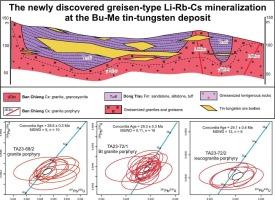The newly discovered Li-Rb-Cs mineralization at the Bu Me Sn-W greisen deposit within the Truong Son orogenic belt in Vietnam
IF 3.6
2区 地球科学
Q1 GEOLOGY
引用次数: 0
Abstract
The Truong Son Orogenic Belt (TSOB) is one of the most significant orogenic belts within the Indochina block. The Bu Me deposit is located within this belt and has historically been significant for the mining of Sn-W metals. Recently, newly discovered metal assemblages at the Bu Me Sn-W deposit has also shown significant lithium–rubidium–cesium (Li-Rb-Cs) mineralization. To constrain the timing and petrogenesis of the magma and Sn-W-Li-Cs-Rb mineralized, a systematic study involving U–Pb ages dating, as well as whole-rock and minerals chemical analyses, was conducted for the Bu Me deposit. U-Pb zircon geochronology of biotite granite, leucogranite, and granite porphyry indicates that these rocks were emplaced at 29.3 ± 0.2 Ma, 29.2 ± 0.4 Ma, and 28.6 ± 0.3 Ma, respectively. The granites exhibit moderate to high SiO2 content (71.91––74.08 wt%), high total alkali, and a peraluminous signature, classifying them as A2-type granites. Leucogranites and granite porphyries are notably enriched in lithium, with concentrations reaching up to 1400 ppm. Based on detailed observations and characterization of textures and mineral assemblages, three principal mineralization stages have been identified: (1) Early Li-Rb-Ca ± Nb quartz-topaz-mica stage, (2) Sn-W ± sulfides quartz-topaz greisen stage, and (3) Quartz vein stage. Detailed EPMA analyses of minerals from these stages suggest that Li-Rb-Cs-Sn-W mineralization is primarily hosted in minerals such as siderophyllite, protolithionite, cassiterite, and wolframite. These findings demonstrate the significant economic potential of rare metal (Li-Rb-Cs-Sn-W) mineralization in the Truong Son Orogenic Belt.

越南张山造山带布美Sn-W格瑞森矿床新发现的Li-Rb-Cs矿化
张公造山带是印度支那地块内最重要的造山带之一。布美矿床位于该带内,历史上对锡钨金属的开采具有重要意义。最近在布美锡钨矿床新发现的金属组合也显示出明显的锂-铷-铯(Li-Rb-Cs)矿化。为了确定布美矿床岩浆和Sn-W-Li-Cs-Rb矿化的时间和成因,对该矿床进行了系统的U-Pb定年、全岩和矿物化学分析等研究。黑云母花岗岩、白色花岗岩和花岗斑岩的U-Pb锆石年代学表明,这些岩石的侵位时间分别为29.3±0.2 Ma、29.2±0.4 Ma和28.6±0.3 Ma。花岗岩SiO2含量中高(71.91 ~ 74.08 wt%),总碱度高,具有过铝特征,属于a2型花岗岩。白花岗岩和花岗斑岩的锂含量显著富集,最高可达1400 ppm。通过对构造和矿物组合的详细观察和表征,确定了3个主要成矿阶段:(1)早期Li-Rb-Ca±Nb石英-黄玉-云母阶段,(2)Sn-W±硫化物石英-黄玉灰岩阶段,(3)石英脉阶段。对这些阶段矿物的详细EPMA分析表明,Li-Rb-Cs-Sn-W矿化主要存在于诸如菱铁矿、原橄榄石、锡石和黑钨矿等矿物中。这些发现证明了张山造山带稀有金属(Li-Rb-Cs-Sn-W)成矿的巨大经济潜力。
本文章由计算机程序翻译,如有差异,请以英文原文为准。
求助全文
约1分钟内获得全文
求助全文
来源期刊

Ore Geology Reviews
地学-地质学
CiteScore
6.50
自引率
27.30%
发文量
546
审稿时长
22.9 weeks
期刊介绍:
Ore Geology Reviews aims to familiarize all earth scientists with recent advances in a number of interconnected disciplines related to the study of, and search for, ore deposits. The reviews range from brief to longer contributions, but the journal preferentially publishes manuscripts that fill the niche between the commonly shorter journal articles and the comprehensive book coverages, and thus has a special appeal to many authors and readers.
 求助内容:
求助内容: 应助结果提醒方式:
应助结果提醒方式:


